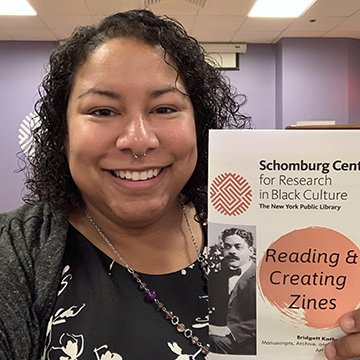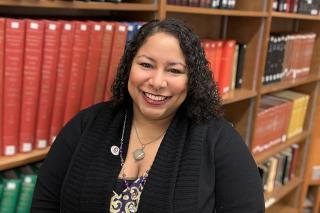Why did you choose to pursue a dual master's degree?

The library and information science archives and history program allowed me to pursue both of my passions at the same time. My goals were, and continue to be, bringing marginalized voices to the surface. As a queer woman of color, I am often searching for representations of myself in culture and history. By learning the skills to find and interpret information, and the skills to impact how librarians and archivists record this information, I hope to influence better practices when it comes to the collection, organization, preservation, and access to the stories of marginalized voices.
Why did you choose to attend Simmons?
One of my sorority sisters attended Simmons and recommended it. When I was first looking into grad schools, Simmons had one of the top archives programs in the country. I also appreciated that the two master's programs worked together to allow students to earn both degrees simultaneously. I was excited by the prospect of living on the east coast for the first time, and the opportunity to drink in all of the cultural institutions nearby.
Tell us about the Schomburg Center for Research in Black Culture.
The Schomburg Center for Research in Black Culture is one of four research libraries in the New York Public Library system. It began as a small research collection in the 135th Street Library purchased from Puerto Rican born bibliophile, Arturo Schomburg, in 1925. Mr. Schomburg collected thousands of items including artwork, music, books, pamphlets, documents, and more that were created by Black people. These items documented the creativity, lives, and genius of their creators.
At the Schomburg, we are devoted to Schomburg’s mission of research, and preservation of the work of Black folks. We exhibition over 11 million items focused on African American, African diaspora, and African experiences. We have five divisions focused on format: the Jean Blackwell Research and Reference division; Art and Artifacts; Manuscripts, Archives, and Rare Books; Photographs and Prints; and Moving Image and Recorded Sound.
In a field dominated by whiteness, the Schomburg Center caters to the experiences of Black folks around the world and supports an incredibly diverse staff to serve our patrons.
Tell us about your current position there.
I'm the reference librarian for the Manuscripts, Archives and Rare Books Division, and Art and Artifacts Division. I'm also in the first class of Rare Book School Mellon Cultural Heritage Fellows. My roles are in public services — I teach classes, meet with researchers, serve patrons in our reading room, answer email reference questions, create research guides, and present materials from our collections during public programs.
Since COVID-19 has taken over all of our lives, my responsibilities have shifted slightly. I still meet with researchers, teach classes, and give presentations, but I have had to adapt to the virtual platform. I have spent much more time working on Research Guides during this time. I recently published a guide on Black Queer Archival Research and will begin work on a guide detailing the history of Black Protest through archival materials soon.
What’s your favorite part of your job?
My favorite part of my job is teaching classes. For each class, I get to conduct research in collections that fall within the scope of the visiting class. I get to pull items that promote the diversity of archival research, showing off letters, clothing, music scores, and so much more. I'm especially excited to be leading zine workshops, which encourage learners to examine their relationship to historical study through documents and images, into telling stories through collage, journal entries, and self-exploration. The students constantly amaze me with their thoughtful creations.
I also love that I work in an environment that affirms Black Life daily. Especially in this time of civil and political unrest, where we continue to see Black men and women murdered at the hands of police, I am thankful that I work in an institution that understands and shares in my grief. I am surrounded by Black men and women who are committed to documenting the lives of the people in our community and teaching through these items.
How did Simmons help prepare you for what you're doing now?
Simmons provided me with tons of leadership opportunities. In joining student groups, I was able to network with my peers and LIS professionals. Before I knew it, I was running LISSA meetings, planning conferences like DERAIL and the Massachusetts Feminist Zine Fest, hosting networking events for Boston librarians of color, and being asked to speak at local conferences like SLA and NEA. I became very comfortable speaking to large groups and organizing events.
I gained an immense amount of experience working as the User Services Librarian at Beatley Library and loved working with undergraduate and SLIS student workers. My favorite class, the "Library Test Kitchen," trained me to think about how artists and educators use archives, and how to teach with creativity at the center of class outcomes. Now I teach classes, present on research, and demystify the archives every day, and almost always center women of color in the conversation.
In a large institution like the New York Public Library, with over 90 branches, I use my networking and leadership skills daily by talking to both patrons and librarians to help connect folks to the resources they need. I talk about how materials can be used to amplify the stories of Black folks with students from elementary school to post-graduate work.

